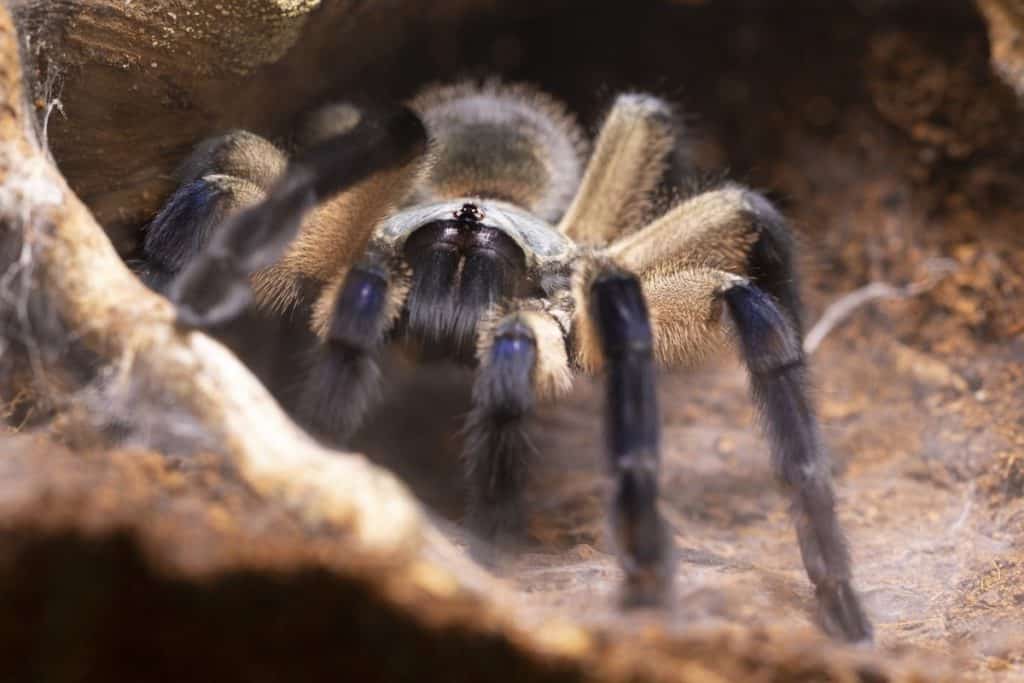Whenever you are considering bringing home a tarantula, it is important to consider the cost associated with the spider. Being able to afford everything your arachnid needs will ensure that your tarantula stays happy and healthy from day one.
How much does it cost to keep a tarantula? Most species of tarantulas generally cost between $20 USD and $150 USD. A lot of your expenses are only one-time expenses: the enclosure, substrate, and any accessories you may want or need. In general, the upfront cost associated with buying a tarantula is going to be between $100 and $250.
However, there are also costs that you will have to regularly pay in order to continue to care for your tarantula. These costs include things like food, substrate, cleaning products, and any health issues that might come up. These costs will usually be somewhere around $50 USD a year, or possibly more if you end up needing an emergency vet visit or decide to get health insurance.
In the rest of this article, we are going to go over the specifics of how much tarantulas cost to keep as a pet. We are going to go over both the one-time costs and other recurring costs.
The Cost of Owning a Tarantula: One-Time Expenses – $130-400 USD
You will likely spend the most you are going to spend right at the beginning when you are first preparing to bring home your tarantula. This includes things like the price of the actual tarantula, the price of the terrarium, and a variety of different accessories. In this section, we are going to go over all of the different one-time costs you can expect when setting up your tarantula’s environment.
| Expenses | Initial Cost (USD) | Monthly Cost (USD) | Yearly Cost (USD) |
|---|---|---|---|
| Tarantula | $20-$150 | – | – |
| Terrarium | $50-$150 | – | – |
| Water Dish | $5-$10 | – | – |
| Plants | $10 | – | – |
| Decor | $10-$20 | – | – |
| Hide | $5-$10 | – | – |
| Lights | $10-$25 | – | – |
| Thermometer | $5 | – | – |
| Hydrometer | $5-$10 | – | – |
| Food | $5 | $2-$5 | $25-$60 |
| Substrate | $5 | $2-$5 | $25-$50 |
| Cleaning Products | – | $0-$1 | $5-$10 |
| Health Expenses | – | $0-$200 | $0-$200 |
| TOTAL EXPENSES | $130-$400 | $5-$205 | $50-$320 |
Cost of a tarantula – $20-150 USD
Tarantulas come at a wide range of different prices depending on the type/breed of tarantula that you want. Generally speaking, the more common beginner species are much more affordable than the ones sought after by tarantula fanatics. Below you will find a list of the different prices for ten great beginner species.
- Chilean Rose Tarantulas: $20 – $25
- Palomino Blonde Tarantulas: $35 – $45
- Pink Toe Tarantulas: $25 – $30
- Mexican Red Knee Tarantulas: $40 – $150
- Costa Rican Zebra Tarantulas: $30 – $35
- Brazilian Black Tarantulas: $100
- Antilles Pink Toe Tarantulas: $85 – $95
- Chaco Golden Knee Tarantulas: $35 – $65
- Mexican Red Rump Tarantulas: $25 – $30
- Green Bottle Blue Tarantulas: $60 – $80
Factors that might affect the price of a tarantula
- Gender: Generally speaking, female tarantulas are going to cost more than male tarantulas. There are two main reasons for this price difference. First, for almost every breed of tarantula, males have a shorter life span. Because you will have a female tarantula longer, they tend to be a bit more expensive. The second reason is that female tarantulas have the potential to produce spiderlings.
- Slings vs. Mature Tarantulas: A sling is a very young tarantula after it has come out of the egg. At this stage, you cannot tell whether the tarantula is going to be a male or a female, and therefore they tend to be cheaper. On the other hand, while you do spend a bit more if you buy a mature tarantula, you will have a lot more information about the spider you are bringing home.
- New World Vs. Old World Tarantulas: New World tarantulas tend to be more common and better for beginners, so they are generally less expensive than Old World tarantulas. However, it depends a lot more on the breed. You will likely be able to find both budget-friendly and very expensive New World and Old World Tarantulas.
Cost of the Terrarium: $50-150 USD
Tarantulas are pets that you look at a lot more than you touch, so they spend a lot of time inside of their enclosures. For this reason, you want to make sure that you provide them with an enclosure that will meet all of their needs and be big enough that they will be comfortable. Generally, you will be able to find a terrarium that is big enough for between $50 and $150 USD depending on the style and quality.
A general rule of thumb is that the bottom of your tarantula’s enclosure should be four times as wide and four times as long as your spider’s leg span. Terrestrial tarantulas generally need flat and wide enclosures, while arboreal tarantulas need a taller enclosure with plenty of things to climb on. Remember, unless you plan to buy multiple enclosures, it is important that you get one that will be big enough for your tarantula when it is fully grown.
Cost of the accessories for your tarantula: $50-90 USD
- Water dish ($5-10 USD) Just like you (and pretty much all living creatures), your tarantula needs water to survive, so you are going to need to provide your tarantula with a water bowl of some sort. You want to get one that looks natural, and that is non-porous, so it is easy to clean. You really only need a small bowl, so you should be able to get one for between 5 and ten dollars. You will need to clean out and refill this bowl every day.
- Plants ($10) Plants will not only make your tarantula’s enclosure look more visibly appealing, but they will also make your tarantula more comfortable. Fake plants are generally better than real plants because they do not require any regular care, which could stress out your tarantula. You will likely be able to buy plenty of fake plants for around 10 dollars, and they should last you forever.
- Decor ($10-20 USD): You may want to buy some extra decor or accessories to help you design your tarantula’s space. Since tarantulas are a pet you mostly just look at, you want to make sure you enjoy looking at the enclosure. If you want to buy decor, you should set aside between $10 and $20.
- Hide ($5-10 USD) Tarantulas like time to themselves, so you need to make sure that you provide your tarantula with at least one hide where your tarantula can relax or take their food. You should be able to find a really good hide for just $5 or $10.
- Lights ($10-25 USD): Tarantulas do not need bright light to be happy, so the only reason you need to get your tarantula a light is if the temperature in your room is too cold for your tarantula to live healthily. If this is the case, you should be able to buy a heat lamp for around $10 – $15. Additionally, some tarantula owners enjoy the aesthetic of red lights for the tarantula enclosure. Red light lamps are usually just under $10.
- Thermometer ($5 USD): By attaching a small thermometer to the side of your tarantula’s cage, you will be able to easily tell if the enclosure is getting too hot or too cold for your tarantulas. From there, you can make adjustments accordingly. You should be able to find a suitable thermometer for $5 or less.
- Hydrometer ($5-10 USD): A hydrometer is very similar to a thermometer, only it measures humidity rather than temperature. There are a lot of different tarantula breeds that need a specific moisture level in order to be healthy and happy. A hydrometer will help you monitor that your tarantula’s cage is at the right level, and then you can make adjustments from there. This will also be about $5 or you can buy a device that is both a thermometer and hydrometer in one for between 5 and 10 dollars.
The Cost of Owning a Tarantula: Recurring Expenses – $5-205 USD/month

1. Food: $2-5 USD/month
Of course, food is a very important part of taking care of any pet, including tarantulas, and it is an expense that you are going to have to deal with from the day you bring your tarantula home to the day he passes away. The good news is, tarantulas have pretty basic dietary needs and you only really need to feed your tarantula about twice or three times a week.
For the most part, crickets are the best option when it comes to tarantulas because they have a lot of the nutrients your tarantula needs and they cannot dig down and hide in the substrate. They are also relatively inexpensive. For instance, you can buy a box of 500 branded crickets for between $20 and $25. As long as you properly care for the crickets, they should survive long enough that you only need to buy crickets a few times a year.
You can even allow your crickets to breed if you want to avoid buying crickets all the time. However, if you are going to do this, you will have to spend a little bit more money upfront to make sure you get high-quality crickets, a good enclosure for the crickets, and food to keep the crickets alive and healthy enough to breed.
Other food options that are good for tarantulas and relatively inexpensive include things like worms and cockroaches. Whatever you end up choosing, you should budget about $5-10 USD a month on food.
2. Substrate: $2-5 USD/month
The substrate is the material that is going to line the bottom of your tarantula’s cage. This will make him more comfortable and also give him something to dig around in. It also plays an important role in making sure your tarantula’s cage stays at the proper humidity level.
The best substrates for tarantulas are going to be completely void of sharp pieces, retain moisture, and easy for your tarantula to dig and burrow in. A lot of people choose to go with a coconut fiber substrate for their tarantulas.
You are going to have to change out the substrate every 2-3 months in order to keep your tarantula’s enclosure clean. However, even with regularly switching out your tarantula’s substrate, you will only need to buy a new substrate every few months. Expect to spend around 5 to 10 dollars on a substrate about once a quarter (or every three months.)
3. Accessories: $0-1 USD/month
For the most part, accessories are a one-time cost. For instance, you buy a water bowl for your tarantula, and you can expect that it is going to be the one and only water bowl you are going to buy. However, sometimes things break or get too dirty and you have to replace them. In order to prepare for this, you should generally set aside around $10 a year to replace broken, lost, or dirty accessories.
4. Cleaning Products: $0-1 USD/month
It is very important to find a cleaning product that is natural and will not harm your tarantula. You can look for a natural, animal-safe cleaner, or you can use something like vinegar to safely disinfect the enclosure. Remember, that whatever you use, you should take your tarantula out of the cage before cleaning.
The good news is, you should not end up spending all that much on cleaners. You do not have to do a complete cleanout of your tarantula’s cage all that often and when you do, you likely will not have to use that much cleaner. For that reason, you likely will not be spending more than around $5 a year on cleaning supplies. You will likely spend even less if you decide to go with vinegar as your cleaner.
4. Health Expenses: $0-200 USD (emergency only)
Tarantulas are relatively hands-off pets, which means you should not end up spending too much on health expenses. They are not like cats or dogs that need regular shots and medications. However, there are a few common health problems that you might deal with.
For instance, sometimes tarantulas will have problems molting. If your tarantula ends up unable to complete the molt, it can be fatal, so oftentimes people will take their tarantula to a vet for help. Depending on the vet and where you live, you could expect to pay up to a couple of hundred dollars to treat your tarantula.
Another common problem tarantula face is mites. However, you can usually deal with mites without actually going to the vet. At most pet stores, they sell mite medications for between $20 and $30. Just make sure that you get a medication that is meant for tarantulas.
Finally, a lot of tarantulas deal with dehydration. If this is the case for your tarantula, you can start by trying to treat it at home. The most common way of dealing with dehydration at home is with a separate container lined with a wet paper towel. Allowing your tarantula to stay in this container for about 24 hours can actually fix the problem. However, there is a chance that you will have to take your tarantula to the vet.
If you set aside between 15 and 25 dollars a month for vet bills, you should be able to cover any problems that come up as your spider ages and grows.
Should You Get Health Insurance for a Pet Tarantula?
The cost of pet insurance can vary a lot from place to place and plan to plan, but it usually costs a few hundred dollars a year. However, it can save you a lot of money in the long run if your pet ends up needing a pricier medicine or medical procedure. But is it really necessary for a pet like a tarantula?
The answer to this really depends on the individual owner and where you live. If there is a vet in your area that specializes in arachnids, you may decide that you want to take your tarantula to the vet regularly, and therefore, pet insurance might be worth it to you.
On the other hand, if there is not a vet in your area that takes care of tarantulas or you do not plan to take your tarantula to the vet all that often if at all, pet health insurance likely will not be worth the extra expense.
What Is the Best Place To Buy A Tarantula?
Generally, you want to look for a reputable breeder or specialized pet store that sells tarantulas. While this is a little bit more expensive than picking up a tarantula at a local pet store, your animal will generally be in better health and you will likely be able to get more information and help.
Is It Possible To Get A Tarantula For Free?
While you probably will not find any pet stores handing out tarantulas for free, you can try to wait around and see if anyone in your community or social circles has a tarantula that they do not want anymore. Great places to start are Craiglist or some Tarantula Facebook groups. This is not a particularly common way to get a tarantula, but it can happen. Sometimes people will buy pets and then realize they do not have the resources or time to care for the pet, and therefore need to give them away.
Are Tarantulas Good Pets?
This is definitely a subjective question, but as long as you like spiders and are happy with a pet that is more hands-off, tarantulas generally make great pets. However, if you are looking for an animal that you can handle and play with all the time, you might want to look at some other pet options.
Is Owning A Tarantula Hard?
This depends a lot on the type of tarantula you get. There are some tarantula species (especially old-world tarantulas) that can be really tricky to care for. However, as long as you get a beginner species and do your research, you should not have too hard of a time learning to care for your tarantula. They are usually pretty low-maintenance animals as long as you provide them with food, water, and a good enclosure.













